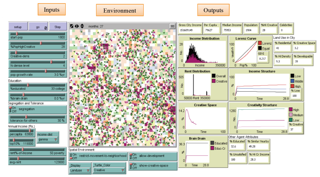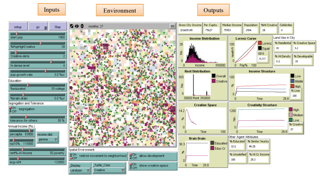Exploring Creativity and Urban Development with Agent-Based Modeling 1.0.0
Scholars and urban planners have suggested that the key characteristic of leading world cities is that they attract the highest quality human talent through educational and professional opportunities. They offer enabling environments for productive human interactions and the growth of knowledge-based industries which drives economic growth through innovation. Both through hard and soft infrastructure, they offer physical connectivity which fosters human creativity and results in higher income levels. When combined with population density, socioeconomic diversity and societal tolerance; the elevated interaction intensity improves productivity. In many developing country cities however, rapid urbanization is increasing sprawl and causing deteriorating in public service standards. We further explore these insights by creating a stylized agent-based model where heterogeneous and independent decision-making agents interact under the following scenarios: (1) improved urban transportation investments; (2) mixed land-use regulations; and (3) reduced residential segregation. We find that any combination of scenarios resulting in conditions of intense human interaction results in greater economic growth. However, model results also demonstrate a clear trade-off between rapid economic progress and socioeconomic equity mainly due to the crowding out of low- and middle-income households from clusters of creativity.

